Discover 11 hidden attractions, cool sights, and unusual things to do in Bryce Canyon National Park (United States). Don't miss out on these must-see attractions: Rainbow Point, Pink Cliffs, and Bryce Canyon Lodge Historic District. Also, be sure to include Utah Parks Company Service Station in your itinerary.
Below, you can find the list of the most amazing places you should visit in Bryce Canyon National Park (Utah).
Table of Contents
Rainbow Point
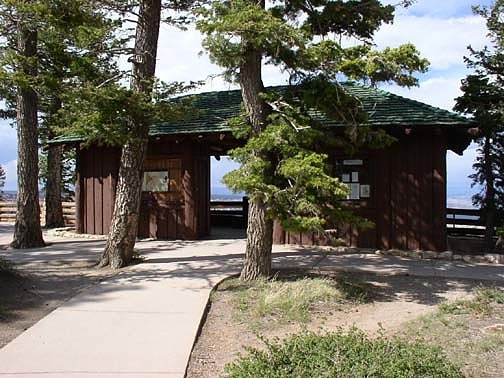
Building. The Rainbow Point Comfort Station and Overlook Shelter in Bryce Canyon National Park, Utah were designed in 1939 by A.V. Jory of the National Park Service Branch of Plans and Designs in the National Park Service Rustic style. Located at the southern end of the Rim Road at Rainbow Point, the buildings were built by the Civilian Conservation Corps in 1940.
The "comfort station", otherwise known as a public toilet, is set back from the rim of Bryce Canyon. The comfort station is designed in the "logs-out" style, sheathed in V-joint wood shiplap siding, with half-round logs covering the joints. The roof is framed with log rafters. The shelter is located directly on the edge of the canyon, facing outwards. The shelter uses massive vertical log posts supporting a log-framed roof. Vertical board siding is used as an infill on the rear half, which is open to the canyon on the front. Siding encloses two small storage areas behind the main interpretive displays.[1]
Address: Southern End of Highway 63, Bryce Canyon National Park
Pink Cliffs
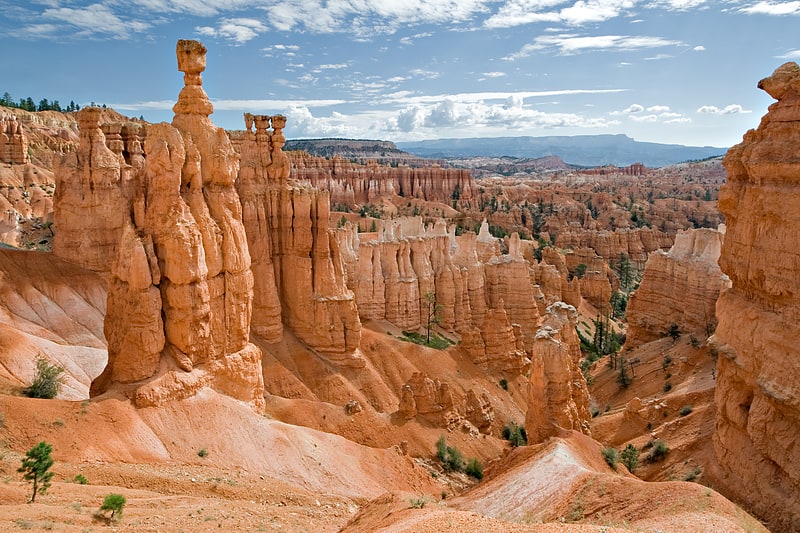
Cliff in Utah. The Pink Cliffs are a series of highly dissected cliffs on the Colorado Plateau in Garfield, Iron, and Kane counties in southwestern Utah, United States. Contrary to the implication of the name, the cliffs are not a single set of rock formations, but actually a geological formation that manifests itself in multiple sets of rock formations.[2]
Bryce Canyon Lodge Historic District
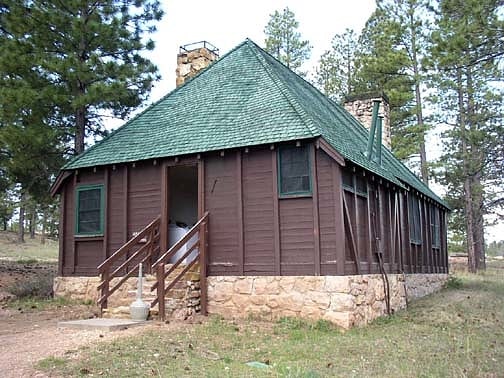
The Bryce Canyon Lodge Historic District surrounds and includes the Bryce Canyon Lodge in Bryce Canyon National Park, as well as the survivors of a large complex of buildings that comprised the core of the park's visitor services area in the 1930s.[3]
Utah Parks Company Service Station
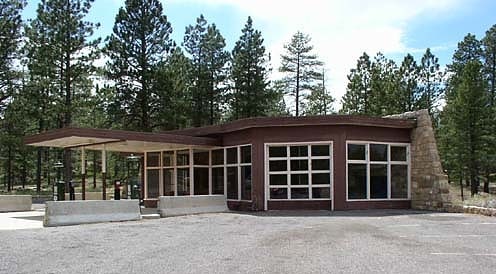
Historical place in Bryce Canyon City, Utah. The Utah Parks Company Service Station in Bryce Canyon National Park was built in 1947 to serve automobile-borne visitors to the park. The service station was designed for the Utah Parks Company by architect Ambrose Spence in a style that was sympathetic to the prevailing National Park Service Rustic style, but was much simpler and more modern in character. In this manner, it foreshadowed the consciously simplified designs developed during the Mission 66 project.
The service station is located between the Bryce Canyon Lodge and Sunrise Point. The dominant feature is a coursed sandstone wall that curves around the structure. The front of the service station is similar to many modern stations, with a series of flat roofs in different planes projecting from the stone wall. A prominent canopy shelters the pumps. The interior comprises a sales room, storage room, service bay and two toilets.
The station was placed on the National Register of Historic Places in 1995.[4]
Old Administration Building

Building in Garfield County, Utah. The Old Administration Building at Bryce Canyon National Park, Utah, U.S.A. also known as the Bryce Canyon Nature Museum, was the first National Park Service building built within the park. Located near Sunrise Point in a heavily used portion of the park, the building was designed by the National Park Service Branch of Plans and Designs in the National Park Service Rustic style preferred at the time for park structures. It is in the immediate vicinity of the Bryce Inn.
The Administration Building was built in 1933 in logs on a stone foundation. The T-shaped 1-1/2 story building was built in two phases. The first phase was the large public room in the eastern portion of the building. The addition contained Park Service office space.[5]
Bryce Canyon Lodge

Lodging. Bryce Canyon Lodge is a lodging facility in Bryce Canyon National Park, Utah, United States, built between 1924 and 1925 using local materials. Designed by architect Gilbert Stanley Underwood, the lodge is an excellent example of National Park Service rustic design, and the only remaining completely original structure that Underwood designed for Bryce Canyon National Park, Zion National Park, and the North Rim of the Grand Canyon.[6]
Old National Park Service Housing Historic District

The Old National Park Service Housing Historic District in Bryce Canyon National Park represents the first housing development within the park specifically designed to house National Park Service employees. Most of these units were intended for unmarried seasonal employees, and were small in scale. The majority were built between 1932 and 1936. Plans were developed by the Park Service Branch of Plans and Design. The district includes several cabins, a ranger dormitory, and a "wood vendor" structure.[7]
Bryce Inn
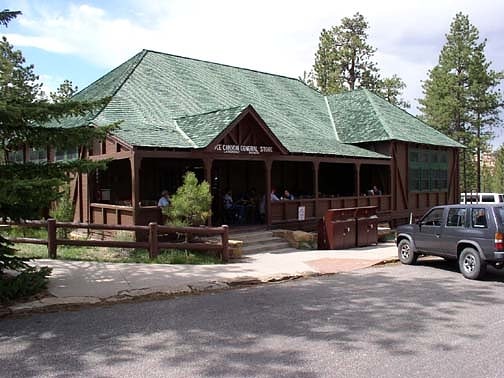
Building in Garfield County, Utah. The Bryce Inn, also known as the Bryce General Store, in Bryce Canyon National Park, Utah was designed by architect Gilbert Stanley Underwood and built in 1932. It was the last major building designed by Underwood for the Utah Parks Company. Designed in the National Park Service Rustic style, the Inn served as the center of a set of "housekeeping cabins" for park visitors, providing a cafeteria, laundry and vending facilities. However, the housekeeping cabins have since been removed, changing the Inn's relationship to its surroundings.
The one-story building has an irregular shape with a partly enclosed porch on the southeast side. Framing is in the "studs-out" style, with the 1" x 6" sheathing applied to the inside of the framing, emphasizing the framing as a decorative pattern on the exterior. The main entry is via the porch, through double doors. A new entry was built in 1973 on the southwest side that is accessible for the disabled. The building presently functions as a store and sells fast food items. This large room features exposed roof structure. Shower and laundry services are in an extension on the northwest side, with separate entries. A 1937 addition at the west end features an exterior stone chimney and a partial basement. The roof is a hipped structure with a wavy shingle pattern.
When the Inn was the center of the housekeeping camp area, providing dining and laundry services for tourists in the cabins. This development, consisting of at least 25 cabins, has since been removed, changing the building's relationship to its surroundings.
The Bryce Inn was placed on the National Register of Historic Places on April 25, 1995.[8]
Bryce Canyon campground comfort stations
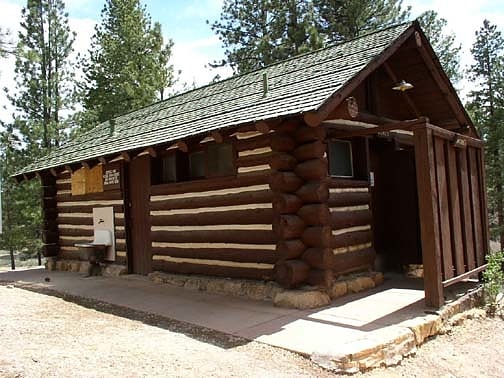
The Loop C Comfort Station and the Loop D Comfort Station are public toilet facilities in Bryce Canyon National Park's North Campground, individually listed on the National Register of Historic Places in 1995 for their significance as structures relating to the park's administrative infrastructure, and for their integrity as examples of rustic architecture. The National Park Service rustic style structures were built in 1935 as part of the first planned campground in the park by Civilian Conservation Corps labor. Plans were developed by the National Park Service Branch of Plans and Designs. Similar facilities in Loops A and B were not built until the 1950s.
The comfort stations are rectangular log buildings of one story. The logs are saddle-notched. The interior has separate facilities for men and women, separated by a utility room. The gable roof is covered with wood shakes. Rafter ends are exposed. The original chopper-cut log ends have been cut down flat.
The comfort stations were individually listed on the National Register of Historic Places on April 25, 1995. The entire campground was considered for eligibility, but retains little historic integrity apart from the two comfort stations.[9]
Bryce Canyon National Park

National park in Utah. Bryce Canyon National Park is an American national park located in southwestern Utah. The major feature of the park is Bryce Canyon, which despite its name, is not a canyon, but a collection of giant natural amphitheaters along the eastern side of the Paunsaugunt Plateau. Bryce is distinctive due to geological structures called hoodoos, formed by frost weathering and stream erosion of the river and lake bed sedimentary rocks. The red, orange, and white colors of the rocks provide spectacular views for park visitors. Bryce Canyon National Park is much smaller and sits at a much higher elevation than nearby Zion National Park. The rim at Bryce varies from 8,000 to 9,000 feet.
The Bryce Canyon area was settled by Mormon pioneers in the 1850s and was named after Ebenezer Bryce, who homesteaded in the area in 1874. The area around Bryce Canyon was originally designated as a national monument by President Warren G. Harding in 1923 and was redesignated as a national park by Congress in 1928. The park covers 35,835 acres (55.992 sq mi; 14,502 ha; 145.02 km2) and receives substantially fewer visitors than Zion National Park (nearly 4.3 million in 2016) or Grand Canyon National Park (nearly 6 million in 2016), largely due to Bryce's more remote location. In 2018, Bryce Canyon received 2,679,478 recreational visitors, which was an increase of 107,794 visitors from the prior year.[10]
Horse Barn
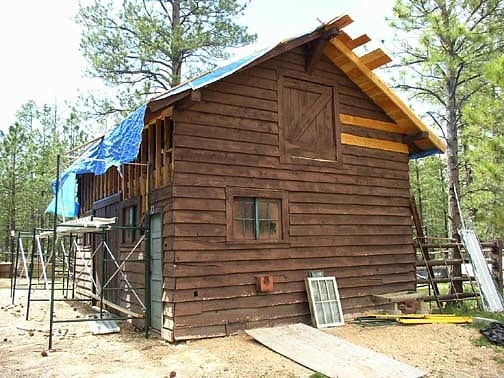
Building in Garfield County, Utah. The Horse Barn at Bryce Canyon National Park, Utah, is a rustic structure built in 1929, shortly after the National Park Service assumed control of the new park lands from the U.S. Forest Service. The Park Service set about improving facilities in the park, using a design by the Park Service Branch of Plans and Designs. It is listed on the National Register of Historic Places as an example of NPS design work of the late 1920s.
The barn measures about 18 by 21.5 feet (5.5 by 6.6 m). The wood-frame building is covered in 12 inches (300 mm) weatherboards and rests on a concrete slab. The west side features a board-and-batten entry door with a small vision light. with a four-by-four light sliding window on the main level and a four-light hopper window in the gable. The east side includes a four-by-four light sliding window on the main level and a board-and-batten door for hay in the gable. The south side includes board doors flanked by four-by-four sliding windows and a paneled entry door at the south end. The interior of the barn has been converted to a mechanic's shop. It consists of two small rooms and one large room, with board wall finishes in the small rooms and gypsum wallboard finish in the larger room. The barn has been moved from its original location to a small collection of NPS and Utah Parks Company structures that were moved to the site from the 1950s. The original site was close to the present Old National Park Service Housing Historic District.
The barn was listed on the National Register of Historic Places on April 25, 1995.[11]